Whole Transcriptome Analyses of Apricots and Japanese Plum Fruits after 1-MCP (Ethylene-Inhibitor) and Ethrel (Ethylene-Precursor) Treatments Reveal New Insights into the Physiology of the Ripening Process
Abstract
1. Introduction
2. Results
2.1. Monitoring of Fruit Quality and Postharvest Traits
2.2. De Novo Transcriptome Assembly, Functional Annotation, and Transcripts Classification
2.3. Global Gene Expression, Gene Ontology, and Pathway Enrichment Analysis
2.4. Differentially Gene Expression (DEG) Analysis between Treatments
2.5. Interaction Analysis of Proteins Related to DEGs
2.6. qPCR Validation
3. Discussion
3.1. Monitoring of Fruit Quality and Postharvest Traits
3.2. De Novo Transcriptome Assembly, Functional Annotation, and Transcripts Classification
3.3. DEGs, PPI, and Related Pathways
4. Materials and Methods
4.1. Plant Material, Experimental Design, and Evaluation of Fruit Quality and Postharvest
4.2. RNA Isolation, Sequencing, and De Novo Assembly
4.3. Gene Expression Profile, Gene Ontology, and Network Analysis
4.4. RT-qPCR Validation
5. Conclusions
Supplementary Materials
Author Contributions
Funding
Institutional Review Board Statement
Informed Consent Statement
Data Availability Statement
Conflicts of Interest
References
- Rubio, P.; Infante, R. Preconditioning “Goldrich” and “Robada” apricots (Prunus armeniaca L.) harvested at two maturity stages. Acta Hortic. 2010, 862, 605–612. [Google Scholar] [CrossRef]
- Ceccarelli, A.; Farneti, B.; Frisina, C.; Allen, D.; Donati, I.; Cellini, A.; Costa, G.; Spinelli, F.; Stefanelli, D. Harvest Maturity Stage and Cold Storage Length Influence on Flavour Development in Peach Fruit. Agronomy 2018, 9, 10. [Google Scholar] [CrossRef]
- Maré, L.; Huysamer, M.; Dodd, M.C.; Truter, A.B.; Kemp, A.T.; Holcroft, D. Extension of the storage life of plums (Prunus salicina) using controlled atmosphere shipping. V Int. Postharvest Symp. 2005, 682. [Google Scholar] [CrossRef]
- Sohail, M.; Khalil, S.; Afridi, S.; Khan, R.U.; Ahmad, T.; Ullah, F. Enhancing Post Harvest Storage Life of Peach Fruits Using Calcium Chloride. J. Chem. Soc. Pak. 2013, 35, 109–113. [Google Scholar]
- Mahajan, B.V.C.; Dhillon, W.S.; Kumar, M.; Singh, B. Effect of different packaging films on shelf life and quality of peach under super and ordinary market conditions. J. Food Sci. Technol. 2015, 52, 3756–3762. [Google Scholar] [CrossRef]
- Du, X.-L.; Li, H.; Zhou, W.-H.; Liu, Y.; Li, J.-L. Determination of Quality Changes in Peaches Wrapped in Active Paper and Stored at Ambient Temperature in Summer. Sci. Rep. 2017, 7, 11830. [Google Scholar] [CrossRef]
- Marty, I.; Sylvie, B.; Sarkissian, G.; Gouble, B.; Audergon, J.-M.; Albagnac, G. Ethylene regulation of carotenoid accumulation and carotenogenic gene expression in colour-contrasted apricot varieties (Prunus armeniaca). J. Exp. Bot. 2005, 56, 1877–1886. [Google Scholar] [CrossRef]
- Veberic, R.; Usenik, V.; Stampar, F. Anthocyanins and fruit colour in plums (Prunus domestica L.) during ripening. Food Chem. 2009, 114, 529–534. [Google Scholar]
- Hörtensteiner, S.; Kräutler, B. Chlorophyll breakdown in higher plants. Biochim. et Biophys. Acta (BBA)-Bioenerg. 2011, 1807, 977–988. [Google Scholar] [CrossRef]
- Wang, D.; Yeats, T.H.; Uluisik, S.; Rose, J.K.C.; Seymour, G.B. Fruit softening: Revisiting the role of pectin. Trends Plant Sci. 2018, 23, 302–310. [Google Scholar] [CrossRef]
- Xi, W.; Zheng, H.; Zhang, Q.; Li, W. Profiling Taste and Aroma Compound Metabolism during Apricot Fruit Development and Ripening. Int. J. Mol. Sci. 2016, 17, 998. [Google Scholar] [CrossRef]
- García-Gómez, B.E.; Salazar, J.A.; Nicolás-Almansa, M.; Razi, M.; Rubio, M.; Ruiz, D.; Martínez-Gómez, P. Molecular Bases of Fruit Quality in Prunus Species: An Integrated Genomic, Transcriptomic, and Metabolic Review with a Breeding Perspective. Int. J. Mol. Sci. 2021, 22, 333. [Google Scholar] [CrossRef]
- Pei, M.; Gu, C.; Zhang, S. Genome-wide identification and expression analysis of genes associated with peach (Prunus persica) fruit ripening. Sci. Hortic. 2019, 246, 317–327. [Google Scholar] [CrossRef]
- Zhang, Q.; Feng, C.; Li, W.; Qu, Z.; Zeng, M.; Xi, W. Transcriptional regulatory networks controlling taste and aroma quality of apricot (Prunus armeniaca L.) fruit during ripening. BMC Genom. 2019, 20, 45. [Google Scholar] [CrossRef] [PubMed]
- García-Gómez, B.E.; Ruiz, D.; Salazar, J.A.; Rubio, M.; Martínez-García, P.J.; Martínez-Gómez, P. Analysis of Metabolites and Gene Expression Changes Relative to Apricot (Prunus armeniaca L.) Fruit Quality During Development and Ripening. Front. Plant Sci. 2020, 11, 1269. [Google Scholar] [CrossRef] [PubMed]
- Liu, M.; Pirrello, J.; Chervin, C.; Roustan, J.-P.; Bouzayen, M. Ethylene Control of Fruit Ripening: Revisiting the Complex Network of Transcriptional Regulation. Plant Physiol. 2015, 169, 2380–2390. [Google Scholar] [CrossRef] [PubMed]
- Borsani, J.; Budde, C.O.; Porrini, L.; Lauxmann, M.A.; Lombardo, V.A.; Murray, R.; Andreo, C.S.; Drincovich, M.F.; Lara, M.V. Carbon metabolism of peach fruit after harvest: Changes in enzymes involved in organic acid and sugar level modifications. J. Exp. Bot. 2009, 60, 1823–1837. [Google Scholar] [CrossRef]
- Wei, H.; Chen, X.; Zong, X.; Shu, H.; Gao, D.; Liu, Q. Comparative Transcriptome Analysis of Genes Involved in Anthocyanin Biosynthesis in the Red and Yellow Fruits of Sweet Cherry (Prunus avium L.). PLoS ONE 2015, 10, e0121164. [Google Scholar] [CrossRef] [PubMed]
- D’Ambrosio, C.; Arena, S.; Rocco, M.; Verrillo, F.; Novi, G.; Viscosi, V.; Marra, M.; Scaloni, A. Proteomic analysis of apricot fruit during ripening. J. Proteom. 2013, 78, 39–57. [Google Scholar] [CrossRef]
- Jiang, L.; Kang, R.; Feng, L.; Yu, Z.; Luo, H. iTRAQ-based quantitative proteomic analysis of peach fruit (Prunus persica L.) at different ripening and postharvest storage stages. Postharvest Biol. Technol. 2020, 164, 111137. [Google Scholar] [CrossRef]
- Gao, J.; Zhang, Y.; Li, Z.; Liu, M. Role of ethylene response factors (ERFs) in fruit ripening. Food Qual. Saf. 2020, 4, 15–20. [Google Scholar] [CrossRef]
- An, J.-P.; Wang, X.-F.; Li, Y.-Y.; Song, L.-Q.; Zhao, L.-L.; You, C.-X.; Hao, Y.-J. EIN3-LIKE1, MYB1, and ETHYLENE RESPONSE FACTOR3 Act in a Regulatory Loop That Synergistically Modulates Ethylene Biosynthesis and Anthocyanin Accumulation. Plant Physiol. 2018, 178, 808–823. [Google Scholar] [CrossRef] [PubMed]
- Fan, X.; Shu, C.; Zhao, K.; Wang, X.; Cao, J.; Jiang, W. Regulation of apricot ripening and softening process during shelf life by post-storage treatments of exogenous ethylene and 1-methylcyclopropene. Sci. Hortic. 2018, 232, 63–70. [Google Scholar] [CrossRef]
- Dal Cin, V.; Rizzini, F.M.; Botton, A.; Tonutti, P. The ethylene biosynthetic and signal transduction pathways are differently affected by 1-MCP in apple and peach fruit. Postharvest Biol. Technol. 2006, 42, 125–133. [Google Scholar] [CrossRef]
- Zuzunaga, M.; Rodríguez, P.; Serrano, M. Responses of Two Plum (Prunus salicina Lindl.) Cultivars to Postharvest Ethylene Treatment. Acta Hortic. 2005, 662, 111–117. [Google Scholar] [CrossRef]
- Mbandi, S.; Hesse, U.; Rees, D.J.; Christoffels, A. A glance at quality score: Implication for de novo transcriptome reconstruction of Illumina reads. Front. Genet. 2014, 5, 17. [Google Scholar] [CrossRef] [PubMed]
- Mousavi, S.; Alisoltani, A.; Shiran, B.; Fallahi, H.; Ebrahimie, E.; Imani, A.; Houshmand, S. De Novo Transcriptome Assembly and Comparative Analysis of Differentially Expressed Genes in Prunus dulcis Mill. in Response to Freezing Stress. PLoS ONE 2014, 9, e104541. [Google Scholar] [CrossRef] [PubMed]
- Manganaris, G.; Rasori, A.; Bassi, D.; Geuna, F.; Ramina, A.; Tonutti, P.; Bonghi, C. Comparative transcript profiling of apricot (Prunus armeniaca L.) fruit development and on-tree ripening. Tree Genet. Genomes 2011, 7, 609–616. [Google Scholar] [CrossRef]
- Prasanna, V.; Prabha, T.N.; Tharanathan, R.N. Fruit Ripening Phenomena—An Overview. Crit. Rev. Food Sci. Nutr. 2007, 47, 1–19. [Google Scholar] [CrossRef]
- Lurie, S.; Zhou, H.-W.; Lers, A.; Sonego, L.; Alexandrov, S.; Shomer, I. Study of pectin esterase and changes in pectin methylation during normal and abnormal peach ripening. Physiol. Plant. 2003, 119, 287–294. [Google Scholar] [CrossRef]
- Lin, Y.; Lin, Y.; Lin, H.; Lin, M.; Li, H.; Yuan, F.; Chen, Y.; Xiao, J. Effects of paper containing 1-MCP postharvest treatment on the disassembly of cell wall polysaccharides and softening in Younai plum fruit during storage. Food Chem. 2018, 264, 1–8. [Google Scholar] [CrossRef] [PubMed]
- Tian, T.; Qiao, G.; Wen, Z.; Deng, B.; Qiu, Z.; Hong, Y.; Wen, X. Comparative transcriptome analysis reveals the molecular regulation underlying the adaptive mechanism of cherry (Cerasus pseudocerasus Lindl.) to shelter covering. BMC Plant Biol. 2020, 20, 27. [Google Scholar] [CrossRef] [PubMed]
- Chen, Y.-H.; Khanal, B.; Linde, M.; Debener, T.; Alkio, M.; Knoche, M. Expression of putative aquaporin genes in sweet cherry is higher in flesh than skin and most are downregulated during development. Sci. Hortic. 2018, 244, 304–314. [Google Scholar] [CrossRef]
- Kesari, R.; Trivedi, P.K.; Nath, P. Gene expression of pathogenesis-related protein during banana ripening and after treatment with 1-MCP. Postharvest Biol. Technol. 2010, 56, 64–70. [Google Scholar] [CrossRef]
- Fabi, J.P.; Seymour, G.B.; Graham, N.S.; Broadley, M.R.; May, S.T.; Lajolo, F.M.; Cordenunsi, B.R.; Oliveira do Nascimento, J.R. Analysis of ripening-related gene expression in papaya using an Arabidopsis-based microarray. BMC Plant Biol. 2012, 12, 242. [Google Scholar] [CrossRef]
- Li, T.; Li, M.; Jiang, Y.; Duan, X. Genome-wide identification, characterization and expression profile of glutaredoxin gene family in relation to fruit ripening and response to abiotic and biotic stresses in banana (Musa acuminata). Int. J. Biol. Macromol. 2021, 170, 636–651. [Google Scholar] [CrossRef]
- Zhang, Z.; Jiang, S.; Wang, N.; Li, M.; Ji, X.; Sun, S.; Liu, J.; Wang, D.; Xu, H.; Qi, S.; et al. Identification of Differentially Expressed Genes Associated with Apple Fruit Ripening and Softening by Suppression Subtractive Hybridization. PLoS ONE 2016, 10, e0146061. [Google Scholar] [CrossRef]
- Jensen, P.E.; Bassi, R.; Boekema, E.J.; Dekker, J.P.; Jansson, S.; Leister, D.; Robinson, C.; Scheller, H.V. Structure, function and regulation of plant photosystem I. Biochim. Et Biophys. Acta (BBA)-Bioenerg. 2007, 1767, 335–352. [Google Scholar] [CrossRef]
- Waters, M.T.; Wang, P.; Korkaric, M.; Capper, R.G.; Saunders, N.J.; Langdale, J.A. GLK Transcription Factors Coordinate Expression of the Photosynthetic Apparatus in Arabidopsis. Plant Cell 2009, 21, 1109–1128. [Google Scholar] [CrossRef]
- Chen, M.; Ji, M.; Wen, B.; Liu, L.; Li, S.; Chen, X.; Gao, D.; Li, L. GOLDEN 2-LIKE Transcription Factors of Plants. Front. Plant Sci. 2016, 7, 1509. [Google Scholar] [CrossRef]
- Chen, M.; Liu, X.; Jiang, S.; Wen, B.; Yang, C.; Xiao, W.; Fu, X.; Li, D.; Chen, X.; Gao, D.; et al. Transcriptomic and Functional Analyses Reveal That PpGLK1 Regulates Chloroplast Development in Peach (Prunus persica). Front. Plant Sci. 2018, 9. [Google Scholar] [CrossRef] [PubMed]
- Muñoz-Robredo, P.; Rubio, P.; Infante, R.; Campos-Vargas, R.; Manríquez, D.; González-Agüero, M.; Defilippi, B.G. Ethylene biosynthesis in apricot: Identification of a ripening-related 1-aminocyclopropane-1-carboxylic acid synthase (ACS) gene. Postharvest Biol. Technol. 2012, 63, 85–90. [Google Scholar] [CrossRef]
- Sadka, A.; Qin, Q.; Feng, J.; Farcuh, M.; Shlizerman, L.; Zhang, Y.; Toubiana, D.; Blumwald, E. Ethylene Response of Plum ACC Synthase 1 (ACS1) Promoter is Mediated through the Binding Site of Abscisic Acid Insensitive 5 (ABI5). Plants 2019, 8, 117. [Google Scholar] [CrossRef] [PubMed]
- Wang, R.; Xuan, H.; Streif, J. Effect of 1-MCP on Plum (Prunus domestica) Ripening and Quality during Shelf-Life at Room Temperature. Acta Hortic. 2010, 877, 317–322. [Google Scholar] [CrossRef]
- Cao, J.K.; Zhao, Y.M.; Wang, M.; Lü, H.Y.; Jiang, W.B. Effects of 1-methylcyclopropene on apricot fruit quality, decay, and on physiological and biochemical metabolism during shelf-life following long-term cold storage. J. Hortic. Sci. Biotechnol. 2009, 84, 672–676. [Google Scholar] [CrossRef]
- Iqbal, N.; Khan, N.A.; Ferrante, A.; Trivellini, A.; Francini, A.; Khan, M.I.R. Ethylene Role in Plant Growth, Development and Senescence: Interaction with Other Phytohormones. Front. Plant Sci. 2017, 8, 475. [Google Scholar] [CrossRef]
- Lytovchenko, A.; Eickmeier, I.; Pons, C.; Osorio, S.; Szecowka, M.; Lehmberg, K.; Arrivault, S.; Tohge, T.; Pineda, B.; Anton, M.T.; et al. Tomato Fruit Photosynthesis Is Seemingly Unimportant in Primary Metabolism and Ripening But Plays a Considerable Role in Seed Development. Plant Physiol. 2011, 157, 1650–1663. [Google Scholar] [CrossRef]
- Quinet, M.; Angosto, T.; Yuste-Lisbona, F.J.; Blanchard-Gros, R.; Bigot, S.; Martinez, J.-P.; Lutts, S. Tomato Fruit Development and Metabolism. Front. Plant Sci. 2019, 10, 1554. [Google Scholar] [CrossRef]
- Gallie, D. The role of l-ascorbic acid recycling in responding to environmental stress and in promoting plant growth. J. Exp. Bot. 2012, 64, 433–443. [Google Scholar] [CrossRef]
- Fenech, M.; Amaya, I.; Valpuesta, V.; Botella, M.A. Vitamin C Content in Fruits: Biosynthesis and Regulation. Front. Plant Sci. 2019, 9, 2006. [Google Scholar] [CrossRef]
- Wheeler, G.L.; Jones, M.A.; Smirnoff, N. The biosynthetic pathway of vitamin C in higher plants. Nature 1998, 393, 365–369. [Google Scholar] [CrossRef] [PubMed]
- Laing, W.; Martinez-Sanchez, M.; Wright, M.; Bulley, S.; Brewster, D.; Dare, A.; Rassam, M.; Wang, D.; Storey, R.; Macknight, R.; et al. An Upstream Open Reading Frame Is Essential for Feedback Regulation of Ascorbate Biosynthesis in Arabidopsis. Plant Cell 2015, 27, 772–786. [Google Scholar] [CrossRef] [PubMed]
- Salazar, J.; Zapata, P.; Silva, C.; González, M.; Pacheco, I.; Bastías, M.; Meneses, C.; Jorquera, C.; Moreno, I.; Shinya, P.; et al. Transcriptome analysis and postharvest behavior of the kiwifruit ‘Actinidia deliciosa’ reveal the role of ethylene-related phytohormones during fruit ripening. Tree Genet. Genomes 2021, 17, 8. [Google Scholar] [CrossRef]
- Egea, J.; Ruiz, D.; Burgos, L. “Dorada” Apricot. HortScience 2005, 40, 1919–1920. [Google Scholar] [CrossRef]
- Martínez-Romero, D.; Serrano, M.; Guillén, F.; Valero, D. 1-Methylcyclopropene (1-MCP) increased storability in plum (Prunus salicina Lindl. cv. Golden Japan). Acta Hortic. 2003, 599, 71–77. [Google Scholar] [CrossRef]
- Puerta-Gomez, A.F.; Cisneros-Zevallos, L. Postharvest studies beyond fresh market eating quality: Phytochemical antioxidant changes in peach and plum fruit during ripening and advanced senescence. Postharvest Biol. Technol. 2011, 60, 220–224. [Google Scholar] [CrossRef]
- Minas, I.S.; Font I Forcada, C.; Dangl, G.S.; Gradziel, T.M.; Dandekar, A.M.; Crisosto, C.H. Discovery of non-climacteric and suppressed climacteric bud sport mutations originating from a climacteric Japanese plum cultivar (Prunus salicina Lindl.). Front. Plant Sci. 2015, 6, 316. [Google Scholar] [CrossRef]
- Brown, G.S.; Walker, T.D. Indicators of maturity in apricots using biplot multivariate analysis. J. Sci. Food Agric. 1990, 53, 321–331. [Google Scholar] [CrossRef]
- Souty, M.; Audergon, J.M.; Chambroy, Y. Abricot: Les Critères de qualité. L’Arboriculture Fruit. 1990, 430, 16–24. [Google Scholar]
- Nagata, M.; Yamashita, I. Simple Method for Simultaneous Determination of Chlorophyll and Carotenoids in Tomato Fruit. Nippon Shokuhin Kogyo Gakkaishi 1992, 39, 925–928. [Google Scholar] [CrossRef]
- Le Provost, G.; Herrera, R.; Paiva, J.; Chaumeil, P.; Salin, F.; Plomion, C. A micromethod for high throughput RNA extraction in forest trees. Biol. Res. 2007, 40, 291–297. [Google Scholar] [CrossRef] [PubMed]
- Fu, L.; Niu, B.; Zhu, Z.; Wu, S.; Li, W. CD-HIT: Accelerated for clustering the next-generation sequencing data. Bioinformatics 2012, 28, 3150–3152. [Google Scholar] [CrossRef] [PubMed]
- Buchfink, B.; Xie, C.; Huson, D.H. Fast and sensitive protein alignment using DIAMOND. Nat. Methods 2015, 12, 59–60. [Google Scholar] [CrossRef] [PubMed]
- Otasek, D.; Morris, J.H.; Bouças, J.; Pico, A.R.; Demchak, B. Cytoscape Automation: Empowering workflow-based network analysis. Genome Biol. 2019, 20, 185. [Google Scholar] [CrossRef]
- Bindea, G.; Mlecnik, B.; Hackl, H.; Charoentong, P.; Tosolini, M.; Kirilovsky, A.; Fridman, W.-H.; Pagès, F.; Trajanoski, Z.; Galon, J. ClueGO: A Cytoscape plug-in to decipher functionally grouped gene ontology and pathway annotation networks. Bioinformatics 2009, 25, 1091–1093. [Google Scholar] [CrossRef]
- Bindea, G.; Galon, J.; Mlecnik, B. CluePedia Cytoscape plugin: Pathway insights using integrated experimental and in silico data. Bioinformatics 2013, 29, 661–663. [Google Scholar] [CrossRef]
- Reimand, J.; Isserlin, R.; Voisin, V.; Kucera, M.; Tannus-Lopes, C.; Rostamianfar, A.; Wadi, L.; Meyer, M.; Wong, J.; Xu, C.; et al. Pathway enrichment analysis and visualization of omics data using g:Profiler, GSEA, Cytoscape and EnrichmentMap. Nat. Protoc. 2019, 14, 482–517. [Google Scholar] [CrossRef]
- Benjamini, Y.; Hochberg, Y. Controlling the False Discovery Rate: A Practical and Powerful Approach to Multiple Testing. J. R. Stat. Soc. Ser. B (Methodol.) 1995, 57, 289–300. [Google Scholar] [CrossRef]
- Szklarczyk, D.; Gable, A.; Lyon, D.; Junge, A.; Wyder, S.; Huerta-Cepas, J.; Simonovic, M.; Doncheva, N.; Morris, J.; Bork, P.; et al. STRING v11: Protein-protein association networks with increased coverage, supporting functional discovery in genome-wide experimental datasets. Nucleic Acids Res. 2018, 47, D607–D613. [Google Scholar] [CrossRef]
- Trapnell, C.; Pachter, L.; Salzberg, S.L. TopHat: Discovering splice junctions with RNA-Seq. Bioinformatics 2009, 25, 1105–1111. [Google Scholar] [CrossRef]
- Jiang, F.; Zhang, J.; Wang, S.; Yang, L.; Luo, Y.; Gao, S.; Zhang, M.; Wu, S.; Hu, S.; Sun, H.; et al. The apricot (Prunus armeniaca L.) genome elucidates Rosaceae evolution and beta-carotenoid synthesis. Hortic. Res. 2019, 6, 128. [Google Scholar] [CrossRef]
- Huang, Z.; Shen, F.; Chen, Y.; Cao, K.; Wang, L. Chromosome-scale genome assembly and population genomics provide insights into the adaptation, domestication, and flavonoid metabolism of Chinese plum. Plant J. 2021, 108, 1174–1192. [Google Scholar] [CrossRef] [PubMed]
- Tong, Z.; Gao, Z.; Wang, F.; Zhou, J.; Zhang, Z. Selection of reliable reference genes for gene expression studies in peach using real-time PCR. BMC Mol. Biol. 2009, 10, 71. [Google Scholar] [CrossRef] [PubMed]
- Pfaffl, M.W. A new mathematical model for relative quantification in real-time RT-PCR. Nucleic Acids Res. 2001, 29, e45. [Google Scholar] [CrossRef] [PubMed]
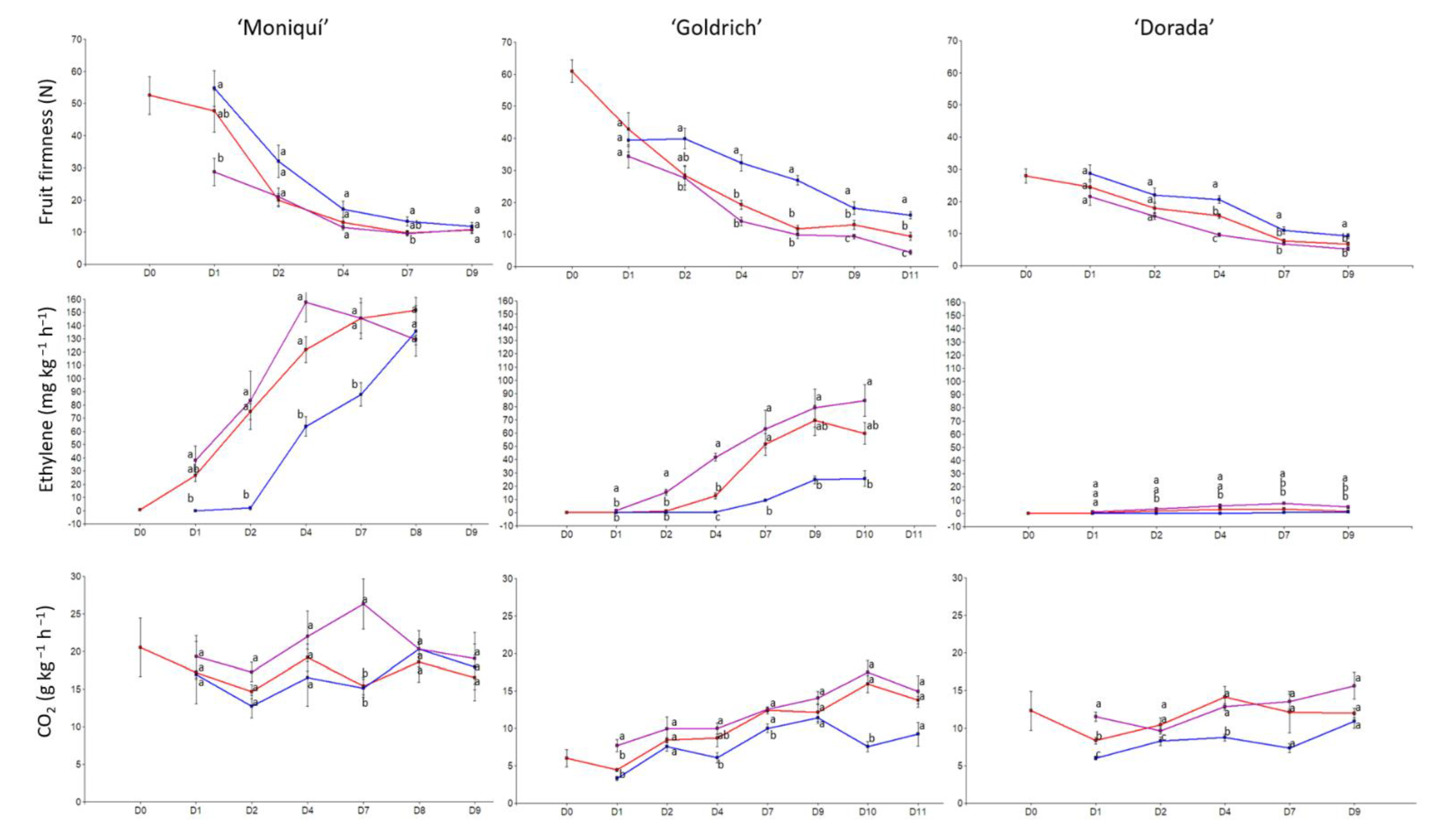

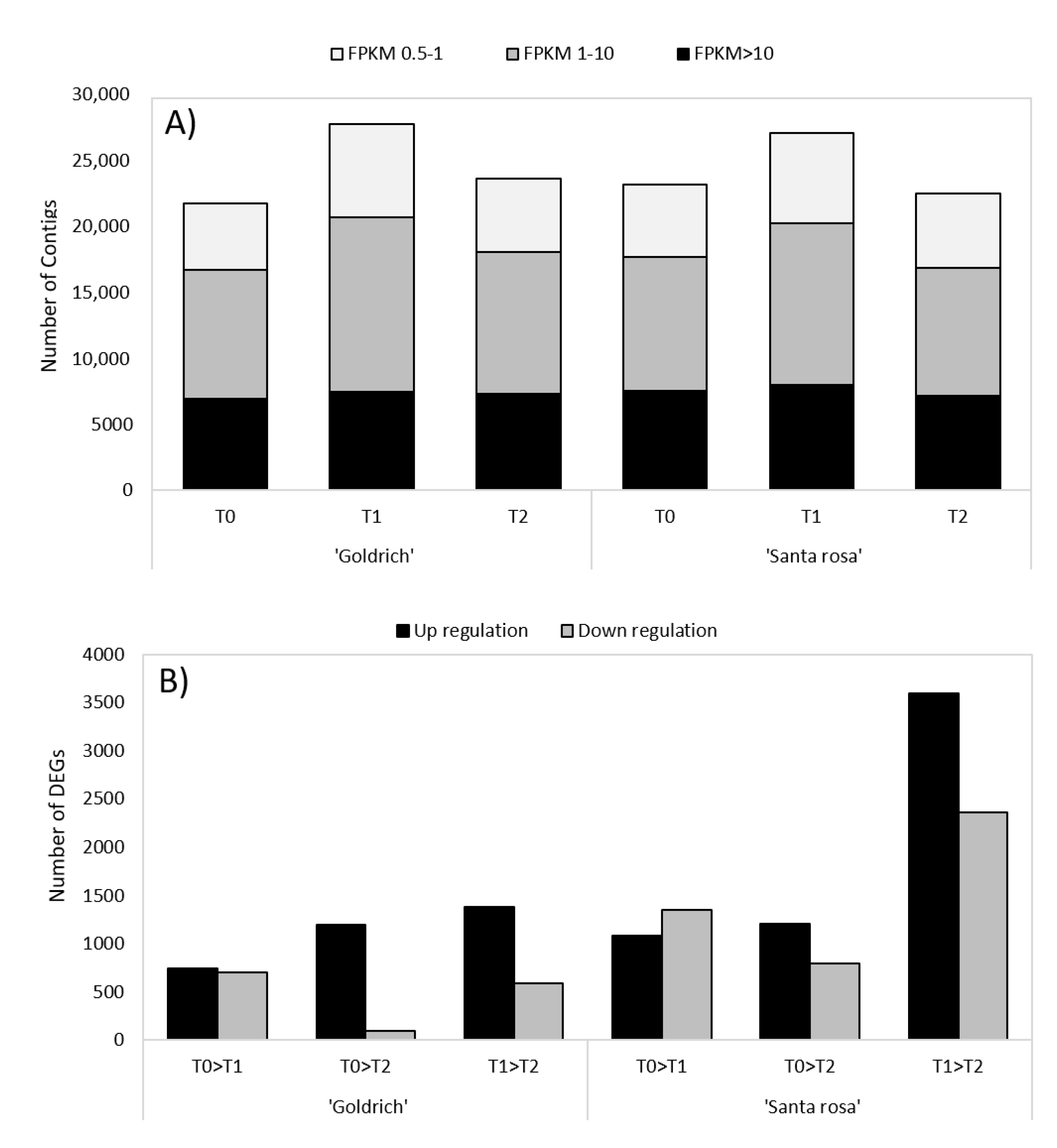
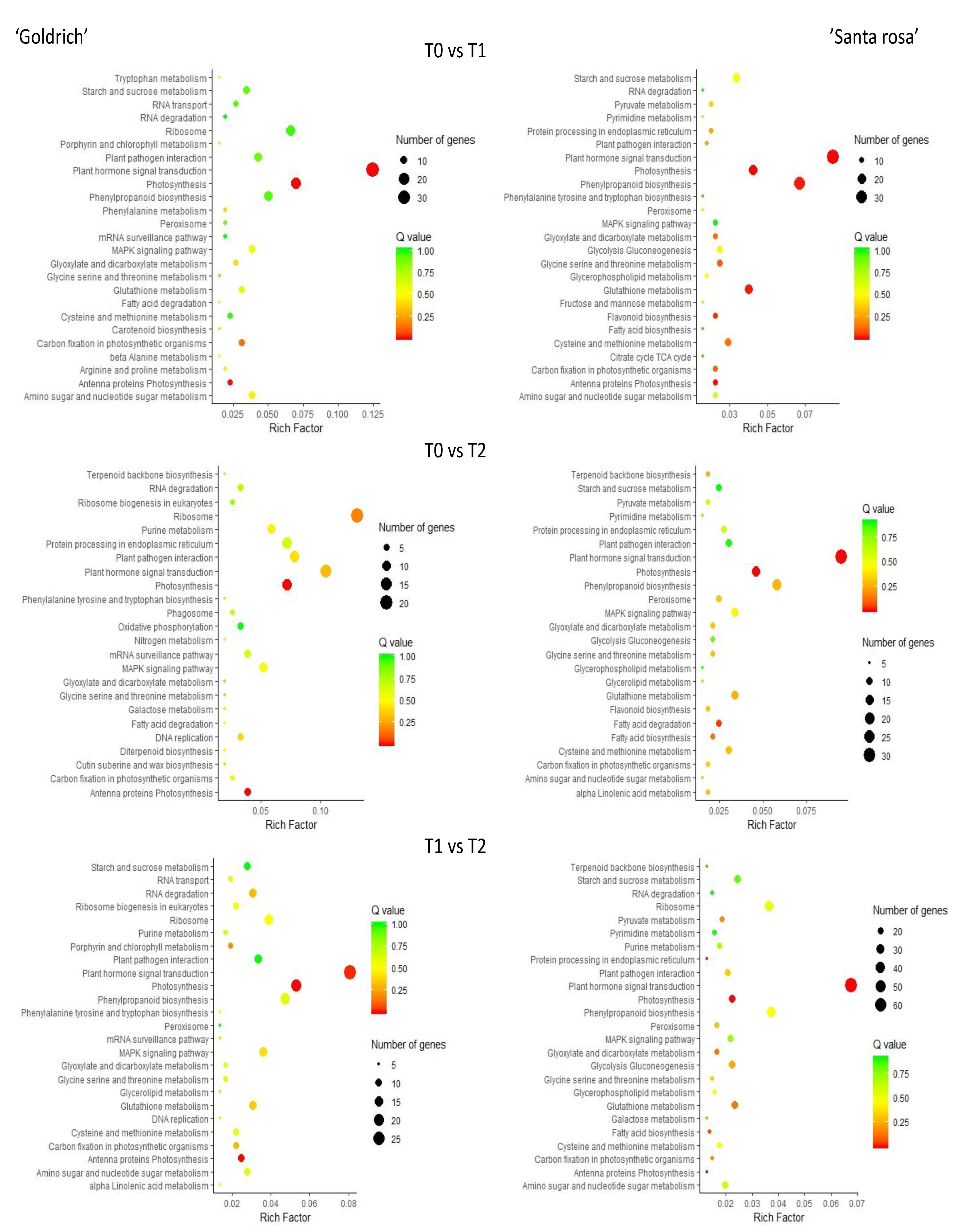


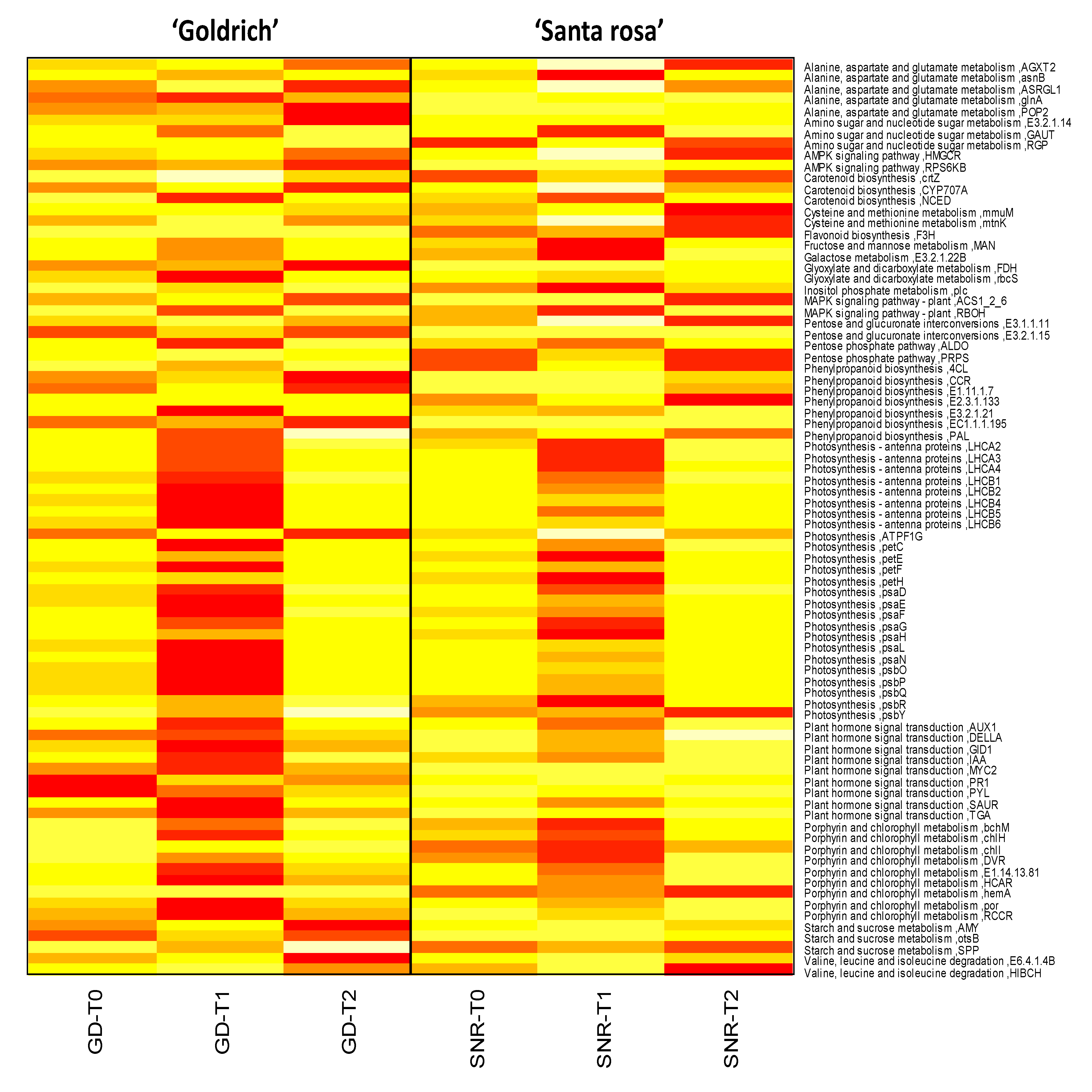
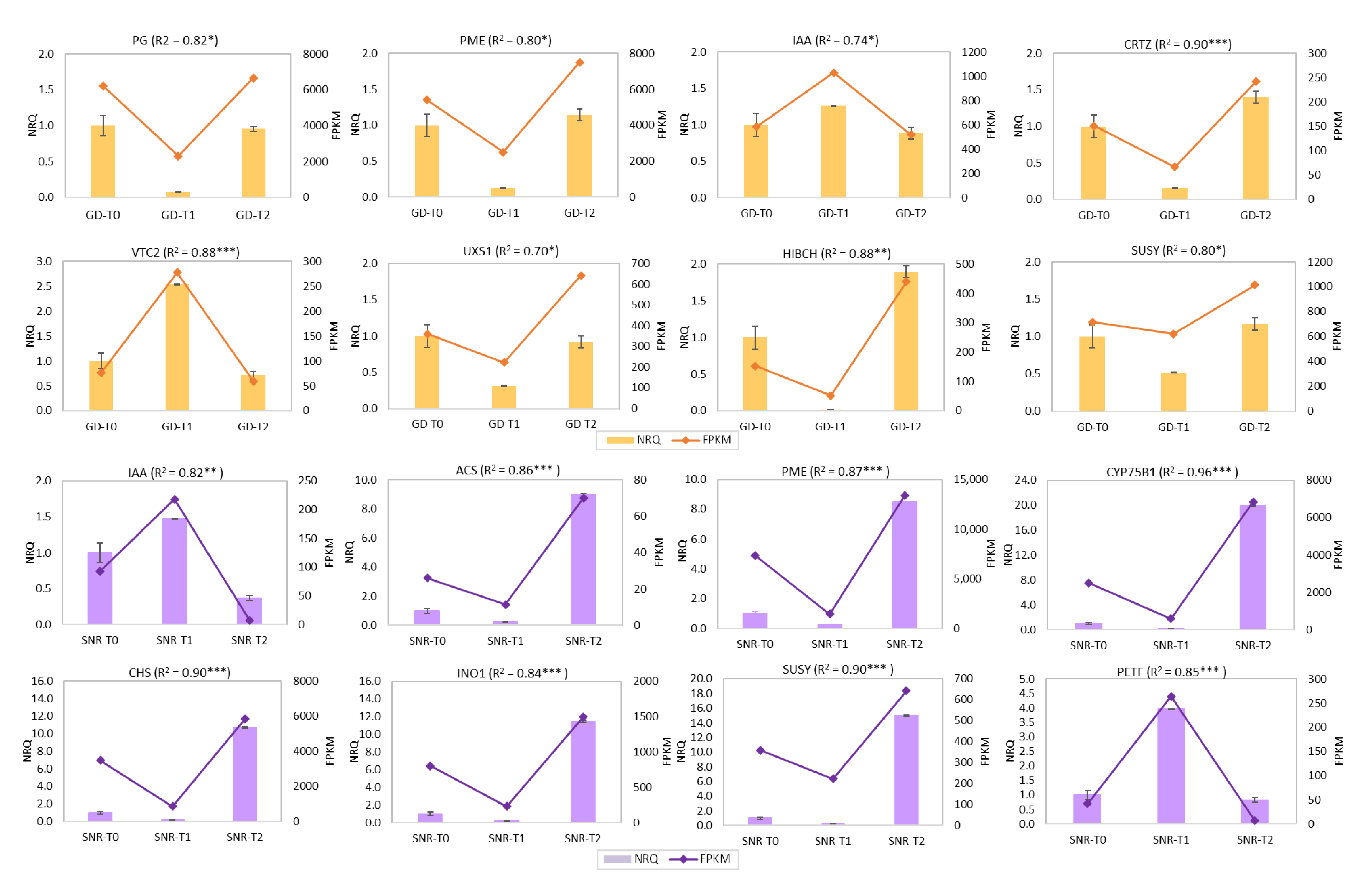
| Variety | Pedigree | Origin | Self-Compatibility | Flowering | Ripening | Skin Color | Flesh Color | Postharvest |
|---|---|---|---|---|---|---|---|---|
| Moniquí | Unknown | Spain | Self-compatible | Late | Intermediate | White–pink | White | Fast |
| Dorada | Bergeron × Moniquí | Spain | Self-compatible | Late | Late | Light orange | Yellow | Intermediate |
| Goldrich | Sunglo × Perfection | USA | Self-incompatible | Late | Intermediate | Orange | Intense orange | Slow |
| Golden Japan | (P. simonii × P. salicina) × (P.cerasifera × P. munsoniana) | USA | Self-incompatible | Late | Early | Golden yellow | Pale yellow | Intermediate |
| Black Splendor | Unknown | USA | Self-incompatible | Early | Early | Blue–black | Red | Intermediate |
| Santa Rosa | Unknown | USA | Self-compatible | Early | Early | Red | Yellow–red | Fast |
| Angeleno | Unknown | USA | Self-incompatible | Late | Late | Purple–black | Yellow | Slow |
| Trait | ‘Moniquí’ | ‘Goldrich’ | ‘Dorada’ | |||||||||
|---|---|---|---|---|---|---|---|---|---|---|---|---|
| Average | SD | Min | Max | Average | SD | Min | Max | Average | SD | Min | Max | |
| FW | 68.62 | 9.22 | 56.10 | 84.13 | 92.35 | 10.88 | 77.57 | 108.47 | 79.19 | 7.22 | 68.37 | 87.18 |
| OVC | 1.13 | 0.83 | 0.00 | 2.00 | 0.30 | 0.48 | 0.00 | 1.00 | 0.30 | 0.48 | 0.00 | 1.00 |
| SKC (L*) | 71.03 | 2.31 | 68.63 | 75.33 | 62.94 | 1.02 | 61.00 | 64.39 | 72.27 | 1.27 | 69.92 | 74.04 |
| SKC (a*) | −4.12 | 2.68 | −7.47 | 0.20 | 10.73 | 2.96 | 6.93 | 14.62 | 9.57 | 3.10 | 5.54 | 15.41 |
| SKC (b*) | 43.15 | 3.08 | 38.88 | 48.89 | 48.27 | 2.16 | 44.77 | 50.97 | 50.90 | 1.35 | 48.90 | 53.56 |
| SKC (C) | 43.49 | 3.02 | 39.13 | 49.18 | 49.54 | 2.38 | 45.36 | 52.61 | 51.92 | 1.42 | 49.88 | 54.70 |
| SKC (h°) | 95.46 | 3.65 | 89.55 | 100.39 | 77.50 | 3.21 | 73.64 | 82.24 | 79.37 | 3.37 | 73.26 | 83.92 |
| FLSC (L*) | 69.53 | 3.04 | 63.64 | 74.35 | 63.79 | 1.02 | 62.36 | 65.42 | 69.36 | 2.64 | 63.02 | 72.59 |
| FLSC (a*) | −2.21 | 1.11 | −3.49 | −0.48 | 18.39 | 1.25 | 16.16 | 19.70 | 6.71 | 1.46 | 4.88 | 9.29 |
| FLSC (b*) | 26.90 | 1.47 | 24.68 | 29.06 | 49.57 | 1.21 | 47.10 | 50.89 | 48.09 | 1.67 | 45.41 | 51.27 |
| FLSC (C) | 27.02 | 1.44 | 24.93 | 29.22 | 52.89 | 1.21 | 50.45 | 54.51 | 48.58 | 1.76 | 45.67 | 51.65 |
| FLSC (h°) | 94.79 | 2.44 | 90.96 | 98.17 | 69.63 | 1.33 | 68.17 | 72.32 | 82.11 | 1.57 | 79.31 | 83.86 |
| SSC | 14.50 | 0.26 | 14.30 | 14.80 | 12.57 | 0.93 | 11.80 | 13.60 | 13.13 | 0.21 | 12.90 | 13.30 |
| MALIC | 1.64 | 0.02 | 1.62 | 1.65 | 3.10 | 0.04 | 3.05 | 3.13 | 1.06 | 0.10 | 0.96 | 1.15 |
| SSC/MALIC | 8.86 | 0.18 | 8.67 | 9.02 | 4.05 | 0.28 | 3.78 | 4.35 | 12.42 | 1.17 | 11.57 | 13.75 |
| Trait | ‘Santa Rosa’ | ‘Black Splendor’ | ‘Golden Japan’ | ‘Angeleno’ | ||||||||||||
|---|---|---|---|---|---|---|---|---|---|---|---|---|---|---|---|---|
| Average | SD | Min | Max | Average | SD | Min | Max | Average | SD | Min | Max | Average | SD | Min | Max | |
| FW | 55.88 | 8.29 | 46.32 | 73.99 | 82.60 | 12.97 | 63.47 | 104.49 | 45.08 | 7.30 | 35.98 | 63.71 | 70.39 | 8.74 | 59.86 | 86.00 |
| OVC | 4.00 | 0.00 | 4.00 | 4.00 | 4.00 | 0.00 | 4.00 | 4.00 | 4.00 | 0.00 | 4.00 | 4.00 | 4.00 | 0.00 | 4.00 | 4.00 |
| SKC (L*) | 34.28 | 1.77 | 31.65 | 37.09 | 28.69 | 1.95 | 26.46 | 31.97 | 60.36 | 1.21 | 57.85 | 62.79 | 35.95 | 3.22 | 32.15 | 41.67 |
| SKC (a*) | 25.31 | 2.76 | 20.85 | 29.40 | 8.80 | 2.77 | 4.75 | 14.02 | −6.79 | 0.78 | −7.81 | −5.50 | 19.81 | 3.45 | 14.43 | 26.03 |
| SKC (b*) | 8.46 | 1.89 | 5.65 | 11.06 | 1.16 | 1.36 | −0.98 | 3.97 | 38.74 | 2.10 | 35.61 | 42.21 | 5.76 | 3.55 | 2.52 | 14.48 |
| SKC (C) | 26.71 | 3.20 | 21.60 | 31.42 | 9.04 | 2.90 | 5.13 | 14.58 | 39.37 | 2.03 | 36.31 | 42.64 | 20.80 | 4.34 | 14.68 | 29.78 |
| SKC (h°) | 18.23 | 2.11 | 15.15 | 21.42 | 11.11 | 5.88 | 2.76 | 21.09 | 99.97 | 1.34 | 97.97 | 101.68 | 15.09 | 5.78 | 8.83 | 29.08 |
| FLSC (L*) | 52.91 | 3.48 | 46.87 | 58.73 | 33.45 | 2.35 | 28.70 | 37.26 | 54.59 | 2.43 | 49.52 | 57.91 | 53.81 | 1.22 | 51.95 | 56.28 |
| FLSC (a*) | 15.87 | 7.58 | 0.62 | 24.88 | 28.50 | 2.27 | 24.47 | 33.05 | −4.61 | 0.70 | −5.90 | −3.38 | −7.32 | 0.74 | −8.33 | −6.12 |
| FLSC (b*) | 28.70 | 3.40 | 24.12 | 33.77 | 13.01 | 1.67 | 9.73 | 15.69 | 31.39 | 1.99 | 27.67 | 34.33 | 36.41 | 1.59 | 33.62 | 39.32 |
| FLSC (C) | 33.82 | 1.25 | 32.47 | 36.01 | 31.37 | 2.65 | 26.34 | 36.25 | 31.75 | 1.99 | 27.97 | 34.61 | 37.15 | 1.55 | 34.36 | 39.82 |
| FLSC (h°) | 61.27 | 14.17 | 44.05 | 88.89 | 24.37 | 1.65 | 21.58 | 27.68 | 98.32 | 1.27 | 96.54 | 100.69 | 101.38 | 1.23 | 99.13 | 102.86 |
| SSC | 13.80 | 0.92 | 13.00 | 14.80 | 13.80 | 0.26 | 13.50 | 14.00 | 10.30 | 0.17 | 10.20 | 10.50 | 17.40 | 1.13 | 16.10 | 18.10 |
| MALIC | 2.35 | 0.02 | 2.33 | 2.37 | 1.72 | 0.08 | 1.63 | 1.77 | 2.02 | 0.05 | 1.97 | 2.06 | 1.16 | 0.11 | 1.03 | 1.23 |
| SSC/MALIC | 5.88 | 0.34 | 5.58 | 6.24 | 8.04 | 0.44 | 7.67 | 8.53 | 5.09 | 0.09 | 5.18 | 5.00 | 15.03 | 0.53 | 14.63 | 15.63 |
| Statistics | ‘Goldrich’ | ‘Santa Rosa’ |
|---|---|---|
| Unigene contigs | 65,886 | 78,215 |
| Min. Lenght (bp) | 201 | 201 |
| Max. Lenght (bp) | 13,689 | 14,450 |
| N50 | 1204 | 1256 |
| Annotation by Blast (%) | 61.22 | 60.91 |
| Reads mapped to reference genome (%) | 88.44 * | 97.96 ** |
| Class Code | ‘Goldrich’ | ‘Santa Rosa’ | ||
|---|---|---|---|---|
| No. of Transcripts | % | No. of Transcripts | % | |
| 1554 | 2.36 | 12,192 | 54.10 | |
| C | 4558 | 6.92 | 33,465 | 21.41 |
| E | 33,310 | 50.56 | - | - |
| I | 8257 | 12.53 | - | - |
| O | 3032 | 4.60 | 4535 | 5.60 |
| P | 2647 | 4.02 | 4655 | 1.92 |
| U | 7722 | 11.72 | 17,155 | 10.09 |
| X | 4806 | 7.29 | 6213 | 6.87 |
| Total | 65,886 | 100 | 78,215 | 100 |
Publisher’s Note: MDPI stays neutral with regard to jurisdictional claims in published maps and institutional affiliations. |
© 2022 by the authors. Licensee MDPI, Basel, Switzerland. This article is an open access article distributed under the terms and conditions of the Creative Commons Attribution (CC BY) license (https://creativecommons.org/licenses/by/4.0/).
Share and Cite
Salazar, J.A.; Ruiz, D.; Zapata, P.; Martínez-García, P.J.; Martínez-Gómez, P. Whole Transcriptome Analyses of Apricots and Japanese Plum Fruits after 1-MCP (Ethylene-Inhibitor) and Ethrel (Ethylene-Precursor) Treatments Reveal New Insights into the Physiology of the Ripening Process. Int. J. Mol. Sci. 2022, 23, 11045. https://doi.org/10.3390/ijms231911045
Salazar JA, Ruiz D, Zapata P, Martínez-García PJ, Martínez-Gómez P. Whole Transcriptome Analyses of Apricots and Japanese Plum Fruits after 1-MCP (Ethylene-Inhibitor) and Ethrel (Ethylene-Precursor) Treatments Reveal New Insights into the Physiology of the Ripening Process. International Journal of Molecular Sciences. 2022; 23(19):11045. https://doi.org/10.3390/ijms231911045
Chicago/Turabian StyleSalazar, Juan A., David Ruiz, Patricio Zapata, Pedro J. Martínez-García, and Pedro Martínez-Gómez. 2022. "Whole Transcriptome Analyses of Apricots and Japanese Plum Fruits after 1-MCP (Ethylene-Inhibitor) and Ethrel (Ethylene-Precursor) Treatments Reveal New Insights into the Physiology of the Ripening Process" International Journal of Molecular Sciences 23, no. 19: 11045. https://doi.org/10.3390/ijms231911045
APA StyleSalazar, J. A., Ruiz, D., Zapata, P., Martínez-García, P. J., & Martínez-Gómez, P. (2022). Whole Transcriptome Analyses of Apricots and Japanese Plum Fruits after 1-MCP (Ethylene-Inhibitor) and Ethrel (Ethylene-Precursor) Treatments Reveal New Insights into the Physiology of the Ripening Process. International Journal of Molecular Sciences, 23(19), 11045. https://doi.org/10.3390/ijms231911045








